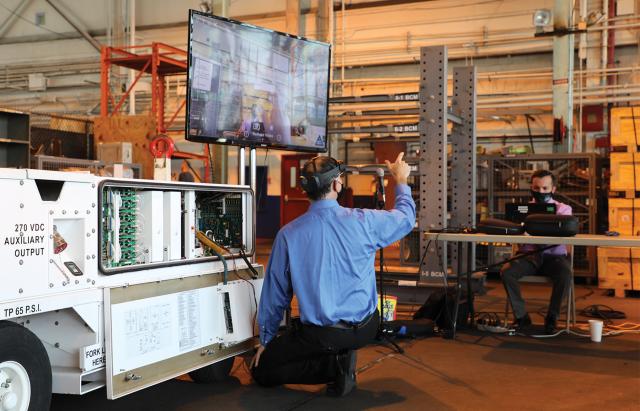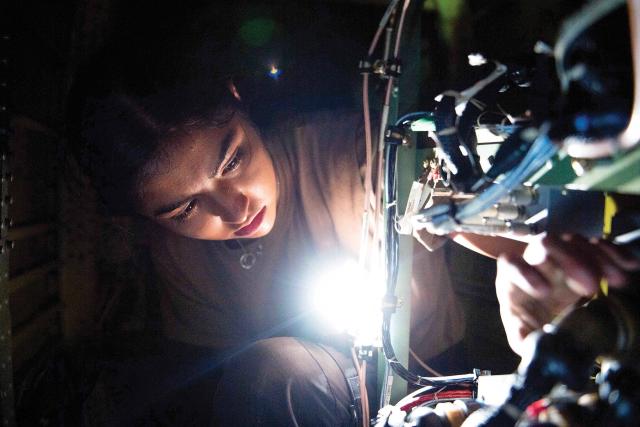With annual maintenance budgets falling short and great-power competition increasing operational demands, ships and shipyards have neither the funding nor the time to complete critical upkeep.1 An estimated 60 percent of ships do not get out of maintenance periods on time, says Chief of Naval Operations Admiral Michael M. Gilday, who attributes 25–30 percent of delays to “bad planning and forecasting.”2 Attack submarines awaiting maintenance in 2008–18 “sat idle for 10,363 days,” according to the Government Accountability Office.3
During that same period, the naval aviation community experienced a threefold increase in Class C mishaps—$50,000 to $500,000 in damages to aircraft or a nonfatal injury—and the Marine Corps’ aviation mishaps more than doubled.4 Then–commander of Naval Air Forces Atlantic, Rear Admiral Roy Kelley, told the House Armed Services Committee most mishaps occurred “during routine maintenance evolutions,” largely because enlisted maintainers “lacked sufficient experience and training.”5
If unchecked, these failures will leave the Navy unprepared to face a near-peer competitor challenge. Predictive maintenance—the fusion of data from a multitude of sensors paired with advanced analytics capabilities geared to predict equipment breakdowns before they occur—can vastly outperform traditional maintenance techniques. It is sorely needed to reverse the force’s slow decay while saving money and man hours fleetwide. Likewise, additive manufacturing (also known as three-dimensional [3D] printing) and augmented reality (AR) are mature technologies that can solve other Navy maintenance problems. The service’s Standard Organization and Regulations Manual specifies that “U.S. Navy ships shall be maintained in the highest practical level of material readiness to meet required operational availability needs.”6 To achieve this, the Navy must adopt a new approach and use already proven technologies.
Changes Are Needed in Maintenance Scheduling
The surface navy constructs and manages its maintenance around planned scheduling software called SKED. This system directs sailors to schedule and perform preventative maintenance at routine intervals, before specific events, or when they believe it is required. However, SKED does not take into account any of the particularities, including how much the equipment is used during a period of time, the environment, or external factors that may impact lifetime or performance. As a result, without sailor input, a chill water pump for a ship’s air conditioning plant that runs for tens of hours per quarter receives the same routine maintenance as another pump that operates for thousands of hours during the same quarter. Context also matters: A pump taking water from the salty, warm waters of the South China Sea receives the same maintenance checks as one that processes water from the less-salty, much colder Bering Sea, even though the two pumps decay at different rates. Sometimes this is effective, but usually it results in either (1) unnecessary maintenance that wastes sailors’ time and Navy resources; or (2) ineffective maintenance that does not address underlying issues in the equipment.
In many cases, equipment does not receive sufficient attention unless it breaks or behaves so erratically that sailors notice—which, given the taxing schedule of underway life and manning shortfalls, is increasingly unlikely.7 Ultimately, forecasting maintenance requires both large amounts of usable data and effective analysis. The Navy has systems in place to collect and store data from equipment, but it lacks the sharing and processing capabilities to leverage fully the data to better understand and forecast conditions that result in equipment breakage, and to make smaller corrections before major ones are required.
In an effort to improve data collection, the Navy recently installed the Integrated Condition Assessment System (ICAS) on Machinery Control System–equipped ships.8 ICAS monitors sensor data from various pieces of engineering equipment and even sends the information off ship. Watchstanders take note of “red readings,” those that do not meet operating specifications. If a ship experiences consistent red readings on a certain piece of equipment, the engineering officer and main propulsion assistant receive an auto-generated email warning them that a specific system is not functioning properly. But ICAS’s major shortfall is that it is limited to monitoring only engineering equipment. Combat systems equipment, which consists mainly of circuit cards and other electronics, is not monitored by the same system. Moreover, the red readings are not used differently from their paper-based alternative. Watchstanders look at the readings, annotate discrepancies, and may request technical support to correct the problem, if they are able to spot it. Often this leaves the burden with ships’ crews to determine the root cause and take corrective action.
In other words, ICAS is little more than a series of well-placed sensors—and the current 1970s-era maintenance, material, and management (3M) system has not undergone fundamental changes since its inception. While ICAS represents a major step in the right direction, without constant analysis and feedback to improve maintenance, what the Navy has now is new sensor technology combined with old processes. The 3M system must be updated. A paradigm shift is in order.
Predictive and Preventative Maintenance Differ
Predictive maintenance is predicated on conditions rather than time, making it proactive instead of just preventative. Sensors attached to key components continuously monitor equipment conditions such as temperature, voltage, speed, vibration, and other performance data to ensure they fall within acceptable limits. The sensors feed into a machine algorithm that learns the characteristics of certain faults—overheating, high vibration, slowing rotations per minute—to allow for automated detection of potential equipment failures. This helps maintainers and supervisors anticipate when something will break before it happens, resulting in fewer surprises, red lines crossed, and missed underway days caused by emergent work. Modern ships and aircraft come with sensors preinstalled for monitoring performance, but without analytics, no real advantages are seen or gained.
Machine learning can change this by making sense of the enormous amount of data coming from those sensors. Even with 20 years of experience at sea, a snipe—whether a machinist mate, boilerman, engineer man, hull technician, or other—cannot have 20 years’ worth of knowledge for each piece of gear, because hours spent underway are not necessarily spent in the plant monitoring specific equipment. But an effective predictive maintenance system can monitor every piece of equipment, everywhere, all the time. Further, a predictive model can draw data fleet wide, from dozens or hundreds of ships, each with years at sea, ingesting readings from each piece of machinery, in various conditions throughout the world, to better understand and predict where equipment might fail so sailors can more effectively direct their efforts. Augmenting sailors with predictive maintenance in human-machine teams will:
• Improve equipment uptime
• Extend equipment lifetime
• Lower cost
• Allow maintainers to focus their limited time on fixing the most at-risk equipment
• Enable supply departments to order critical parts before breakdowns, or parts to be ordered automatically when the system detects imminent failure
• Identify and remove from circulation deficient or mismanufactured batches of parts
• Provide captains and commodores with a granular understanding of the state of each ship’s equipment for better mission planning.9
The Other Services and the Civilian Sector
In industries from manufacturing to transportation, predictive maintenance solutions are being implemented.10 The Navy should exploit commercial technologies rather than build from scratch its own processes and algorithms, following the example of the other services.
The Air Force, taking note of changes in the airline industry, has demonstrated the viability of predictive maintenance and reduced unscheduled maintenance by nearly 30 percent for some platforms.11 With $68 million saved since the inception of its pilot programs, the Air Force planned to triple the amount of aircraft that used predictive maintenance in 2020.12
The Army followed suit with predictive maintenance for the Bradley fighting vehicle, and the Marine Corps invested in predictive maintenance for M88 armored recovery vehicles.13 The Office of the Secretary of the Air Force estimated that scaling predictive maintenance to all Air Force platforms could lead to a 40 percent increase in aircraft uptime.14 The Defense Innovation Unit, a DoD commercial technology acquisition office that helped facilitate the Air Force and Army predictive maintenance contracts, estimated that scaling such maintenance to the entire Air Force could save $15 billion annually.15 By way of comparison, in the 2020 budget, the Navy asked for $23.8 billion in ship procurement and $18.6 billion in aircraft procurement.16 The 2021 requested amount for ships was $19.9 billion.17 Whether the Navy has more or fewer than 355 ships, $15 billion a year in savings would have a substantial impact on procurement and readiness.18
While following the Air Force’s lead, the Navy should capitalize on its two big advantages: the existing infrastructure of ship-based sensors, and the nearly continuous nature of operations. Unlike the other services, the Navy spends much of its time performing presence missions and protecting sea lanes of communications, meaning that about 20–30 percent of ships and submarines are at sea at any given time. In fact, sailors on surface ships spend 23 percent of their time away from home port.19 Unlike aircraft, with more limited flight hours, ships at sea have equipment running 24 hours a day. Machine learning thrives on large amounts of data. If 20 percent of 300 ships are at sea at any one time, they generate more than half a million hours of monitoring data per piece of equipment each year.
Augmented Reality
When predictive maintenance combines with the power of big data and artificial intelligence to identify maintenance problems, augmented reality puts that information in the hands of the maintainers. AR, which enhances users’ vision of objects with superimposed digital information, is already used for maintenance and production in the private sector to reduce human error, save time and money, and improve competency for complex tasks.20 Boeing invested in an AR company that helped cut production time for complex aircraft wiring by 25 percent.21
In the Navy, AR could translate cutting-edge analytics into actionable tasks. For example, on board a surface combatant, predictive maintenance software would detect a problem such as critical parts in a chill water pump giving readings for temperature and vibration on the edge of acceptable ranges, while others vibrated at levels indicating imminent failure. Instead of one person interpreting this data from a computer, then dispatching a maintainer, an integrated system would send the information straight to the machinist mate (MM) tasked with maintaining the pumps.
The machinist mate’s glasses would highlight the different subsystems within the larger air conditioning system, allowing for a view of the critical components. The AR glasses would further display the predicted health ratings of each piece of equipment, as well as past information on temperature or vibration readings, and the equipment’s maintenance history. The history would include any digital notes on the system from previous watchstanders. The MM could determine which issue to address on the appropriate piece of equipment, then pull up the corresponding maintenance requirement card on the glasses with a voice command, and have hands-free access to the needed information in a timely manner.22 Now, with the soon-to-be-broken equipment identified, the maintainer alerted, and the necessary information at his fingertips, maintenance could begin.
As for unexpected complications, AR glasses have a camera that can stream video back to central or even off-ship to a technical assist site, where what the MM sees is visible to remote experts. This keeps watchstanders fully aware and enables the most experienced snipes or subject matter experts to guide a sailor through the troubleshooting process. With modern AR software, they could even use the computer to make notes and highlight on the streaming video, allowing for a fluid knowledge transfer in tricky situations in which precision matters most.
AR is also a game-changer for training purposes, particularly valuable in light of the aviation community’s recent maintenance problems. The Navy should follow the Army in using AR and simulation by using existing technology for maintenance training.23 Instructional videos displayed on AR glasses will help sailors deepen their hands-on understanding of equipment as they conduct walk-throughs of spaces. Tutorials can demonstrate tricky tasks for infrequent or dangerous maintenance, and videos of sailors performing maintenance can be evaluated for competency, training, and improvement.
3D Printing for Real-time Delivery
Even with novel maintenance tools, parts will still break, some so quickly that they cannot be procured in time to meet mission requirements. The ability to 3D-print parts on demand may alleviate the need for emergency underway replenishments or port visits to receive critical parts. Furthermore, the level of technical maturity of additive manufacturing is high and proven on highly technical, yet fragile systems. For example, Relativity Space, a start-up currently working with the Air Force, has demonstrated the ability to 3D-print an entire large rocket.24 On ships the Navy has already used 3D-printed parts, such as a strainer for the high-pressure steam system on board an aircraft carrier.25 While largely a convenience in peacetime, this capability will quickly become critical in wartime, when the Navy’s supply chain will be under attack. Yet only a few ships across the fleet have 3D printers, now seen as neat gadgets rather than vital problem-solving tools. Navy ships of all sizes should be equipped with additive manufacturing technology, and sailors in all Navy warfare communities should be trained in the equipment’s use.
Coordinate Technology
The challenge of keeping ships at sea and maintaining them is fiscally and strategically urgent. U.S. adversaries will gain ground if the Navy’s readiness lags and operational tempo shows no signs of letting up. In his 2020 fragmentary order, CNO Gilday emphasized improving ship maintenance as his first warfighting line of effort—which is further highlighted by the recent addition to the Battle E list of the Purple E: self-sustainment at sea. While gaining in importance, how maintenance is executed has remained relatively unchanged. Abundant sensors and new technology already exist that can help the Navy; they can analyze vast amounts of data and rapidly implement changes to ensure properly maintained equipment. Likewise, the technology is already here to enable rapid training of personnel and manufacturing of critical parts, even while at sea. Advanced analytics, AR, and 3D printing could be quickly and cheaply implemented today into the Navy’s maintenance architecture, with an immediate and tangible impact across the fleet. In the CNO’s words, “It is cheaper to maintain readiness than to buy it back.”26
1. David B. Larter, “Despite Record Budgets, the U.S. Navy Is Short Hundreds of Millions for Maintenance,” Defense News, 19 August 2019; John S. Van Oudenaren, “The Impact of Great Power Competition on the U.S. Navy,” National Interest, 10 April 2019; Robert Faturechi, Megan Rose, and Christian Miller, “Years of Warnings, then Death and Disaster,” Pro Publica, 7 February 2019.
2. ADM Michael Gilday, USN, remarks at 2019 Naval Institute Defense Forum Washington Conference.
3. David B. Larter, “With the Navy’s Submarine Maintenance Woes, There May Yet Be Hope,” Defense News, 8 May 2019.
4. Megan Eckstein, “Less Experienced Mariners Contribute to Rise in Naval Aviation Mishaps,” USNI News, 22 June 2018.
5. Roy Kelley, “Statement on Aviation Readiness and Safety Before the House Armed Services Committee Subcommittee on Readiness,” 21 June 2018.
6. Standard Organization and Regulations of the U.S. Navy, OPNAVINST 3120.23D W CH-1, 29 May 2012.
7. Geoff Ziezulewicz, “No Rest for the Weary: Lack of Sleep Threatens Safety and Readiness,” Navy Times, 19 September 2017; Sam LaGrone, “Fleet Forces: Navy Short 6,200 at-Sea Sailors Now to Meet New Manning Requirements,” USNI News, 26 February 2019.
8. Mike Diulio, “Revolutionizing Maintenance through Remote Monitoring via ICAS & Distance Support,” NAVSEA OSD Great Ideas Program, 28 October 2002.
9. Mark Haarman and Michael Molders, “Predictive Maintenance 4.0 beyond the Hype: PdM 4.0 Delivers Results,” Price Waterhouse Cooper, September 2018.
10. Barbara Bukovac, “Transportation and Logistics Deals Insights,” Price Waterhouse Cooper, 15 May 2021.
11. John Tirpak, “Smart Sustainment,” Air Force Magazine, 1 November 2019. Mark Gruss, “Could Artificial Intelligence Save the Pentagon $15 Billion a Year?” C4ISR Net, 16 April 2019.
12. Rachel Cohen, “USAF Tripling Data Driven Maintenance Efforts in 2020,” Air Force Magazine, 26 May 2020.
13. Sonja Jordan, “Army Investing in Predictive Maintenance for Bradleys,” National Defense, 26 September 2018. Jordan Harper, “Defense Innovation Unit Shifts into Higher Gear,” National Defense, 11 February 2020; Morgan Scott, “U.S. Marine Corps to Use Uptake’s Artificial Intelligence Software to Increase Operational Readiness of M88 Recovery Vehicles,” Uptake, 4 November 2019.
14. Gruss, “Could Artificial Intelligence Save the Pentagon $15 Billion a Year?”
15. Gruss.
16. Congressional Budget Office, “An Analysis of the Navy’s Fiscal Year 2022 Shipbuilding Plan,” 16 September 2021.
17. Lara Seligman, “Navy Prepares to Slash Funding for New Warships,” Foreign Policy, 10 February 2020.
18. Sam LaGrone, “CNO Gilday Calls for Budget Increase to Reach 355 Ship Fleet; New Battle Force Count Won’t Include Unmanned Ships,” USNI News, 14 January 2020.
19. Mark Faram, “The Busiest Ships, Subs, and Squadrons—Who’s Really Away from Home the Most,” Navy Times, 7 March 2018.
20. Kelly Potter, “Augmented Reality Becoming a Focus in Maintenance Technology,” Geospatial World, 16 January 2019.
21. Alwyn Scott, “Boeing Forms Venture Group, Invests in Two Tech Startups,” Reuters, 6 April 2017; Charlie Fink, “How Boeing Uses Upskill Skylight AR to Boost Productivity,” Forbes, 26 February 2019.
22. Lauren Williams, “Army Tests Out Augmented Reality with Training,” Federal Computer Week, 13 October 2020.
23. Jen Judson, “U.S. Army’s Jumping to the Next Level in Virtual Training,” Defense News, 18 May 2019.
24. Michael Sheetz, “3D Printer Relativity Space Is Expanding with Giant New Facility to Build Reusable Rockets,” CNBC, 30 June 2021.
25. Tia Vialva, “NAVSEA Approves First Medal 3D Printed Shipboard Component for U.S. Navy,” 3D Printing Industry, 12 October 2018.
26. Gilday, Fragmentary Order 01/2019 updating A Design for Maintaining Maritime Superiority 2.0, 1 December 2019.





